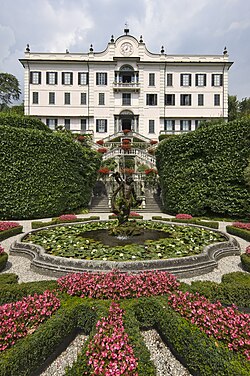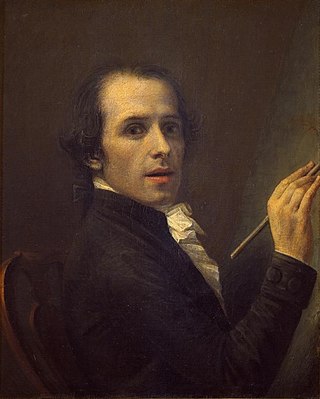
Antonio Canova was an Italian Neoclassical sculptor, famous for his marble sculptures. Often regarded as the greatest of the Neoclassical artists, his sculpture was inspired by the Baroque and the classical revival, and has been characterised as having avoided the melodramatics of the former, and the cold artificiality of the latter.

Albert Bertel Thorvaldsen was a Danish and Icelandic sculptor and medalist of international fame, who spent most of his life (1797–1838) in Italy. Thorvaldsen was born in Copenhagen into a working-class Danish/Icelandic family, and was accepted to the Royal Danish Academy of Art at the age of eleven. Working part-time with his father, who was a wood carver, Thorvaldsen won many honors and medals at the academy. He was awarded a stipend to travel to Rome and continue his education.

Lake Como, also known as Lario, is a lake of glacial origin in Lombardy, Italy.

Bellagio is a comune (municipality) in the Province of Como in the Italian region of Lombardy. It is located on Lake Como, also known by its Latin-derived name Lario, whose arms form an inverted Y. The triangular land mass at the base of the inverted Y is the Larian Triangle: at its northern point sits Bellagio, looking across to the northern arm of the lake and, behind it, the Alps. It has always been famous for its location. It belongs to a mountain community named Comunità montana del Triangolo lariano, based in Canzo.

The Galleria Borghese is an art gallery in Rome, Italy, housed in the former Villa Borghese Pinciana. At the outset, the gallery building was integrated with its gardens, but nowadays the Villa Borghese gardens are considered a separate tourist attraction. The Galleria Borghese houses a substantial part of the Borghese Collection of paintings, sculpture and antiquities, begun by Cardinal Scipione Borghese, the nephew of Pope Paul V. The building was constructed by the architect Flaminio Ponzio, developing sketches by Scipione Borghese himself, who used it as a villa suburbana, a country villa at the edge of Rome.
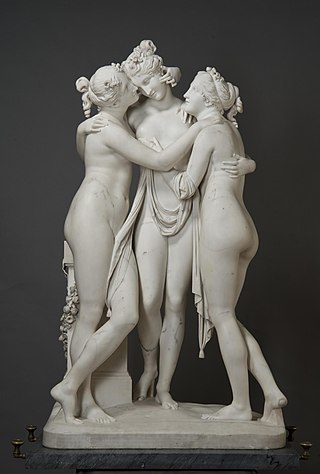
Antonio Canova's statue The Three Graces is a Neoclassical sculpture, in marble, of the mythological three Charites, daughters of Zeus – identified on some engravings of the statue as, from left to right, Euphrosyne, Aglaea and Thalia – who were said to represent youth/beauty (Thalia), mirth (Euphrosyne), and elegance (Aglaea). The Graces presided over banquets and gatherings, to delight the guests of the gods. As such they have served as subjects for historical artists including Sandro Botticelli and Bertel Thorvaldsen. A version of the sculpture is in the Hermitage Museum, and another is owned jointly and exhibited in turn by the Victoria and Albert Museum, Scottish National Gallery while another one is in Galerie Plastik in Hořice.

The Pinacoteca di Brera is the main public gallery for paintings in Milan, Italy. It contains one of the foremost collections of Italian paintings from the 13th to the 20th century, an outgrowth of the cultural program of the Brera Academy, which shares the site in the Palazzo Brera.
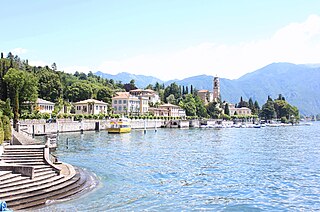
Tremezzo is a comune of some 1,300 people in the Province of Como, in the Italian region Lombardy. It is a member of the I Borghi più belli d'Italia association.
Luigi Acquisti (1745–1823) was an Italian sculptor mainly known for his works in the neoclassical style.
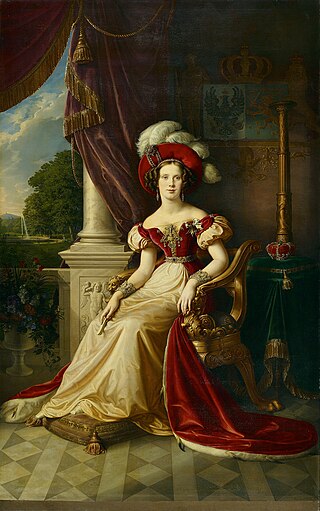
Princess Marianne of the Netherlands, Princess of Orange-Nassau was the youngest child of King William I of the Netherlands and Princess Wilhelmine of Prussia.

Napoleon as Mars the Peacemaker is a colossal heroic nude statue by the Italian artist Antonio Canova, of Napoleon I of France in the guise of the Roman god Mars. He holds a gilded Nike or Victory standing on an orb in his right hand and a staff in his left. It was produced between 1802 and 1806 and stands 3.45 metres to the raised left hand. Once on display in the Louvre in Paris, it was purchased from Louis XVIII in 1816 by the British government, which granted it to the Duke of Wellington. It is now on display in Robert Adam's stairwell at the Duke's London residence, Apsley House.

Porta Sempione is a city gate of Milan, Italy. The name is used both to refer to the gate proper and to the surrounding district (quartiere), a part of the Zone 1 division, including the major avenue of Corso Sempione. The gate is marked by a landmark triumphal arch called Arco della Pace, dating back to the 19th century, although its origins can be traced back to a gate of the Roman walls of Milan.

Ernst Mayer was a German sculptor in the classical style. He was a pupil of Antonio Isopi and worked for Leo von Klenze, mainly in Munich where in 1830 he became Professor of Sculpture at the Polytechnic, now the Technical University.
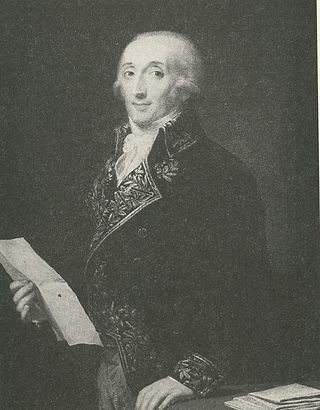
Francesco Melzi d'Eril, Duke of Lodi, Count of Magenta was an Italian politician and patriot, serving as vice-president of the Napoleonic Italian Republic (1802–1805). He was a consistent supporter of the Italian unification ideals that would lead to the Italian Risorgimento shortly after his death.

The Three Graces is a nearly life-size, figurative Carrara marble outdoor sculpture group located on the historic Oldfields estate on the campus of the Indianapolis Museum of Art (IMA), in Indianapolis, Indiana. The neoclassical marble sculpture depicts the Three Graces, minor goddesses of the Greco-Roman pantheon. The group consists of three women frontally oriented, standing in a row upon a base. The sculpture is modeled after a c. 1797 sculpture by Antonio Canova.

The art collections of Fondazione Cariplo are a gallery of artworks with a significant historical and artistic value owned by Fondazione Cariplo in Italy. It consists of 767 paintings, 116 sculptures, 51 objects and furnishings dating from the first century AD to the second half of the twentieth.

Giovanni Battista Comolli was an Italian sculptor.

The Villa Sola-Busca, also called Villa La Quieta, is a Neoclassical style rural palace outside of the town of Tremezzo, on the shores of Lake Como in the Region of Lombardy, Italy.
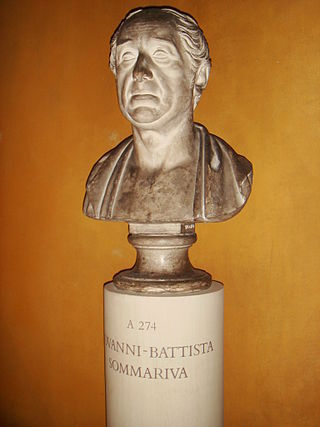
Giovanni or Gian Battista Sommariva was an Italian politician of the Cisalpine Republic and a notable arts patron.
Gennaro Calì was an Italian sculptor.
